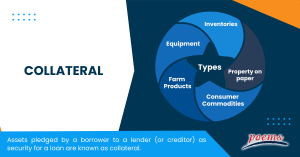Collateral
Table of Contents
Collateral
You might need a loan if you’re a small business owner to finance your enterprise. A business loan is difficult to obtain. Secured loans and unsecured loans are the two types of loans that financial organisations give. The key distinction between the two is the collateral requirement for fast loans.
An asset known as collateral lowers the risk for a lender by shielding him from potential borrower default. Lenders can recover losses by selling the collateral.
What is collateral?
Assets pledged by a borrower to a lender (or creditor) as security for a loan are known as collateral.
Generally speaking, loans with collateral have lower interest rates than loans without. The lender’s risk of default is decreased when business loans are secured. The borrower is also more inclined to repay the loan if they know they could lose their collateral.
Borrowers generally look for credit on factors like commercial real estate, residential or transportation equipment, manufacturing supplies, or even intangibles (like intellectual property) for businesses. If a loan exposure is supported by collateral, it is referred to as a secured credit; otherwise, it is referred to as an unsecured exposure.
Understanding collateral
The interest rates on loans with collateral are typically substantially lower than those on unsecured loans. A lien is a legitimate claim by a lender against a borrower’s property to settle a debt. The borrower has a strong incentive to repay the loan because he risks losing his home or other assets used as collateral if he does not.
The lender may seize collateral—a valuable item—from the borrower if he fails to repay a loan according to the terms stipulated in the agreement. One such example is when you take out a mortgage. The bank will typically require your home as collateral.
This implies that the bank has the authority to seize your property if you are unable to meet the conditions of your mortgage repayment. Collateral guarantees that the lenders will still receive their money even if the borrower defaults on the loan, allowing the bank to sell your home in order to collect the loaned money.
How collateral works
The financial organisation assesses your ability to repay the loan before approving it. It needs some sort of security, which lowers its danger. The lender may seize and sell the deposit if you’re unable to make your loan payment. The potential loss of your asset ensures that you make your loan repayments on time, and the collateral depends on the loan’s terms.
For instance, the collateral for a home loan would be the house itself. Similarly, the car serves as security when you obtain a vehicle loan. A variety of assets can also back other forms of borrowing.
Types of collateral

Consumer commodities, equipment, farm products, inventories, and property on paper are the five basic categories of collateral.
- Customer goods, such as cars, are items that the average consumer buys.
- Items primarily employed in commercial or governmental operations are considered equipment.
- Crops and cattle are examples of farm products.
- Work in progress or raw materials makes up inventory.
Examples of collateral
The following are typical collateral examples:
- Mortgages for homes
A loan with a mortgage uses the home as collateral. The loan servicer may begin legal action if the homeowner misses at least 120 days of mortgage payments. By completing these steps, the lender may eventually be able to foreclose on the property and seize control. Once the property has been transferred to the lender, the remaining principal on loan may be repaid by selling the property.
- Loans for a home equity
A house may also be collateral for a second mortgage or home equity line of credit. The amount of the loan in this situation won’t be greater than the equity that is accessible. For instance, if a home is worth 200,000 US$ and the original mortgage has a balance of 125,000 US$, only 75,000 US$ will be accessible for a second mortgage.
Frequently Asked Questions
Each Family Member of a Requesting Party, SNH, RMR LLC, and any other Person who Constructively Owns Common Shares as a result of attribution under the Code from one or more of the Requesting Parties (or their estates or spouses), SNH, or RMR LLC are all considered “Collateral Persons” (other than SNH and the Requesting Parties, and, upon the death of any Requesting Party who is an individual, their estates and spouses).
Cash and Non-Cash Collateral Management, Swap Agent Operations, Collateral Client Services, Reconciliations, and Change Management make up the Collateral Operations team.
Three factors—the desire to reduce counterparty risk, the ability to enable more favourable pricing of credit risk, and improved market access— contribute to the growing significance of collateral management.
A valuable item is pledged as security for a loan. Collateral reduces the risk to lenders. If a borrower defaults on the loan, the lender has the right to sell the collateral to recoup losses.
Collateral can reduce risk to lenders by providing them with an asset they can seize if the borrower defaults on the loan. This can provide security for the lender and help them recoup their losses if the loan goes bad.
However, it is important to note that collateral is not a fool-proof way to reduce risk, as there is always the possibility that the collateral itself may not be worth enough to cover the loan. In addition, even if the collateral is valuable, the borrower may still default on the loan, in which case the lender would still suffer a loss.
Four qualities of high-quality collateral are:
- Being easily quantifiable and having a value adequate to pay off the loans it is securing.
- Holding its worth for the whole loan term.
- Being easily susceptible to foreclosure or having its ownership changed.
- Being in a liquid state.
Related Terms
- Cost of Equity
- Capital Adequacy Ratio (CAR)
- Interest Coverage Ratio
- Industry Groups
- Income Statement
- Historical Volatility (HV)
- Embedded Options
- Dynamic Asset Allocation
- Depositary Receipts
- Deferment Payment Option
- Debt-to-Equity Ratio
- Financial Futures
- Contingent Capital
- Conduit Issuers
- Calendar Spread
- Cost of Equity
- Capital Adequacy Ratio (CAR)
- Interest Coverage Ratio
- Industry Groups
- Income Statement
- Historical Volatility (HV)
- Embedded Options
- Dynamic Asset Allocation
- Depositary Receipts
- Deferment Payment Option
- Debt-to-Equity Ratio
- Financial Futures
- Contingent Capital
- Conduit Issuers
- Calendar Spread
- Devaluation
- Grading Certificates
- Distributable Net Income
- Cover Order
- Tracking Index
- Auction Rate Securities
- Arbitrage-Free Pricing
- Net Profits Interest
- Borrowing Limit
- Algorithmic Trading
- Corporate Action
- Spillover Effect
- Economic Forecasting
- Treynor Ratio
- Hammer Candlestick
- DuPont Analysis
- Net Profit Margin
- Law of One Price
- Annual Value
- Rollover option
- Financial Analysis
- Currency Hedging
- Lump sum payment
- Annual Percentage Yield (APY)
- Excess Equity
- Fiduciary Duty
- Bought-deal underwriting
- Anonymous Trading
- Fair Market Value
- Fixed Income Securities
- Redemption fee
- Acid Test Ratio
- Bid Ask price
- Finance Charge
- Futures
- Basis grades
- Short Covering
- Visible Supply
- Transferable notice
- Intangibles expenses
- Strong order book
- Fiat money
- Trailing Stops
- Exchange Control
- Relevant Cost
- Dow Theory
- Hyperdeflation
- Hope Credit
- Futures contracts
- Human capital
- Subrogation
- Qualifying Annuity
- Strategic Alliance
- Probate Court
- Procurement
- Holding company
- Harmonic mean
- Income protection insurance
- Recession
- Savings Ratios
- Pump and dump
- Total Debt Servicing Ratio
- Debt to Asset Ratio
- Liquid Assets to Net Worth Ratio
- Liquidity Ratio
- Personal financial ratios
- T-bills
- Payroll deduction plan
- Operating expenses
- Demand elasticity
- Deferred compensation
- Conflict theory
- Acid-test ratio
- Withholding Tax
- Benchmark index
- Double Taxation Relief
- Debtor Risk
- Securitization
- Yield on Distribution
- Currency Swap
- Overcollateralization
- Efficient Frontier
- Listing Rules
- Green Shoe Options
- Accrued Interest
- Market Order
- Accrued Expenses
- Target Leverage Ratio
- Acceptance Credit
- Balloon Interest
- Abridged Prospectus
- Data Tagging
- Perpetuity
- Optimal portfolio
- Hybrid annuity
- Investor fallout
- Intermediated market
- Information-less trades
- Back Months
- Adjusted Futures Price
- Expected maturity date
- Excess spread
- Quantitative tightening
- Accreted Value
- Equity Clawback
- Soft Dollar Broker
- Stagnation
- Replenishment
- Decoupling
- Holding period
- Regression analysis
- Wealth manager
- Financial plan
- Adequacy of coverage
- Actual market
- Credit risk
- Insurance
- Financial independence
- Annual report
- Financial management
- Ageing schedule
- Global indices
- Folio number
- Accrual basis
- Liquidity risk
- Quick Ratio
- Unearned Income
- Sustainability
- Value at Risk
- Vertical Financial Analysis
- Residual maturity
- Operating Margin
- Trust deed
- Profit and Loss Statement
- Junior Market
- Affinity fraud
- Base currency
- Working capital
- Individual Savings Account
- Redemption yield
- Net profit margin
- Fringe benefits
- Fiscal policy
- Escrow
- Externality
- Multi-level marketing
- Joint tenancy
- Liquidity coverage ratio
- Hurdle rate
- Kiddie tax
- Giffen Goods
- Keynesian economics
- EBITA
- Risk Tolerance
- Disbursement
- Bayes’ Theorem
- Amalgamation
- Adverse selection
- Contribution Margin
- Accounting Equation
- Value chain
- Gross Income
- Net present value
- Liability
- Leverage ratio
- Inventory turnover
- Gross margin
- Being Bearish
- Being Bullish
- Commodity
- Exchange rate
- Basis point
- Inception date
- Riskometer
- Trigger Option
- Zeta model
- Racketeering
- Market Indexes
- Short Selling
- Quartile rank
- Defeasance
- Cut-off-time
- Business-to-Consumer
- Bankruptcy
- Acquisition
- Turnover Ratio
- Indexation
- Fiduciary responsibility
- Benchmark
- Pegging
- Illiquidity
- Backwardation
- Backup Withholding
- Buyout
- Beneficial owner
- Contingent deferred sales charge
- Exchange privilege
- Asset allocation
- Maturity distribution
- Letter of Intent
- Emerging Markets
- Cash Settlement
- Cash Flow
- Capital Lease Obligations
- Book-to-Bill-Ratio
- Capital Gains or Losses
- Balance Sheet
- Capital Lease
Most Popular Terms
Other Terms
- Protective Put
- Perpetual Bond
- Option Adjusted Spread (OAS)
- Non-Diversifiable Risk
- Merger Arbitrage
- Liability-Driven Investment (LDI)
- Income Bonds
- Guaranteed Investment Contract (GIC)
- Flash Crash
- Equity Carve-Outs
- Cost Basis
- Deferred Annuity
- Cash-on-Cash Return
- Earning Surprise
- Bubble
- Beta Risk
- Bear Spread
- Asset Play
- Accrued Market Discount
- Ladder Strategy
- Junk Status
- Intrinsic Value of Stock
- Interest-Only Bonds (IO)
- Inflation Hedge
- Incremental Yield
- Industrial Bonds
- Holding Period Return
- Hedge Effectiveness
- Flat Yield Curve
- Fallen Angel
- Exotic Options
- Execution Risk
- Exchange-Traded Notes
- Event-Driven Strategy
- Eurodollar Bonds
- Enhanced Index Fund
- EBITDA Margin
- Dual-Currency Bond
- Downside Capture Ratio
- Dollar Rolls
- Dividend Declaration Date
- Dividend Capture Strategy
- Distribution Yield
- Delta Neutral
- Derivative Security
- Dark Pools
- Death Cross
- Fixed-to-floating rate bonds
- First Call Date
- Firm Order
Know More about
Tools/Educational Resources
Markets Offered by POEMS
Read the Latest Market Journal

Recognising Biases in Investing and Tips to Avoid Them
Common biases like overconfidence, herd mentality, and loss aversion influence both risk assessment and decision-making....

What is Money Dysmorphia and How to Overcome it?
Money dysmorphia happens when the way you feel about your finances doesn’t match the reality...

The Employer’s Guide to Domestic Helper Insurance
Domestic Helper insurance may appear to be just another compliance task for employers in Singapore,...

One Stock, Many Prices: Understanding US Markets
Why Isn’t My Order Filled at the Price I See? Have you ever set a...

Why Every Investor Should Understand Put Selling
Introduction Options trading can seem complicated at first, but it offers investors flexible strategies to...

Mastering Stop-Loss Placement: A Guide to Profitability in Forex Trading
Effective stop-loss placement is a cornerstone of prudent risk management in forex trading. It’s not...

Boosting ETF Portfolio Efficiency: Reducing Tax Leakage Through Smarter ETF Selection
Introduction: Why Tax Efficiency Matters in Global ETF Investing Diversification is the foundation of a...

How to Build a Diversified Global ETF Portfolio
Introduction: Why Diversification Is Essential in 2025 In our June edition article (https://www.poems.com.sg/market-journal/the-complete-etf-playbook-for-singapore-investors-from-beginner-to-advanced-strategies/), we introduced...









